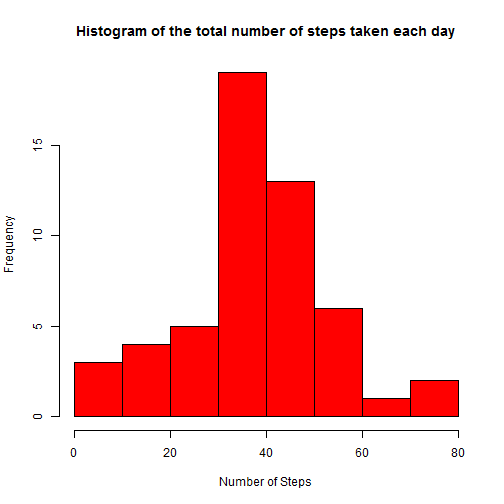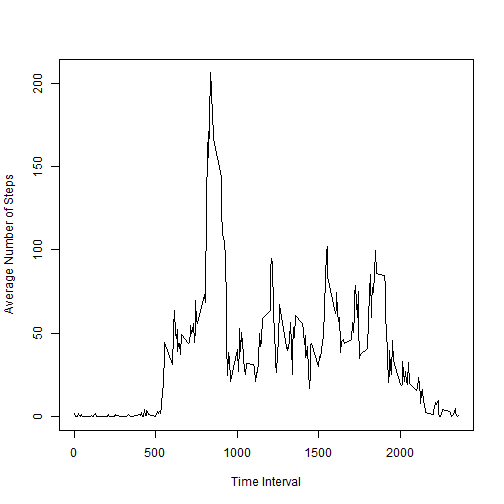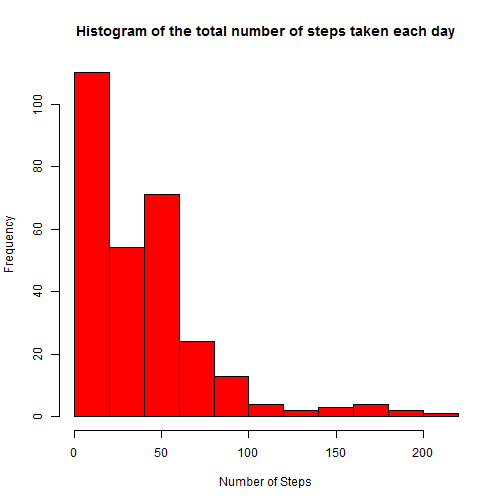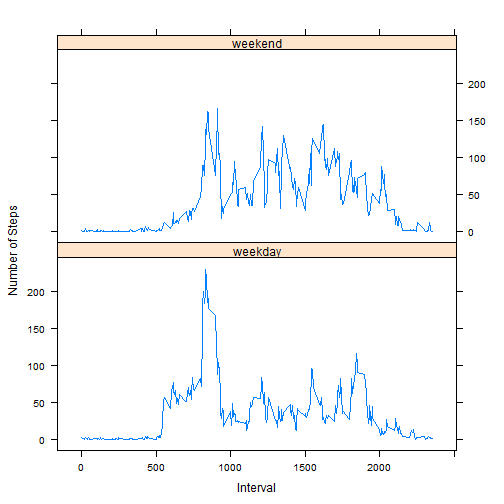In this section we load the data into R and make transformation on the date column to be read as date and not as factor.
data <- read.csv("activity.csv", na.strings = "NA") ##1##
data$date <- as.Date(data$date) ##2##- Plot a histogram of the total number of steps taken in each day.
good <- complete.cases(data$steps, data$date) ## Ignore NAs
plotdata <- data[good, ] ## Ignore NAs
## aggregate based on total steps per date##
totalperday <- aggregate(plotdata$steps, list(Date = plotdata$date), data = plotdata,
mean)
## plot histogram##
hist(totalperday$x, main = "Histogram of the total number of steps taken each day",
xlab = "Number of Steps", col = "red")mean <- mean(totalperday$x)
median <- median(totalperday$x)- Then mean of the number of steps taken per day is 37.3826 and the median of the steps taken per day is 37.3785.
- Plot number of steps averaged across all days
good <- complete.cases(data$steps, data$date) ## Ignore NAs
plotdata <- data[good, ] ## Ignore NAs
## aggregate based on total steps per interval##
total <- aggregate(plotdata$steps, list(Interval = plotdata$interval), data = plotdata,
mean)
## plot graph##
plot(total$Interval, total$x, type = "l", ylab = "Average Number of Steps",
xlab = "Time Interval")## Find maximum time interval
whichmax <- which.max(total$x)
max <- total$Interval[whichmax]- The interval [835,840] contains the maximum number of steps, averaged across all days.
na <- sum(is.na(data$steps))-
The number of missing values in the dataset is 2304.
-
If a value for a 5-minute interval is missing we set the value to be the mean of that 5-minute interval averaged across all days.
-
Plot histogram of the total number of steps per day of the new dataset with the filled missing values.
good <- complete.cases(data$steps, data$date) ## Ignore NAs
plotdata <- data[good, ] ## Ignore NAs
## aggregate based on total steps per interval##
total <- aggregate(plotdata$steps, list(Interval = plotdata$interval), data = plotdata,
mean)
## create new dataset##
newdata <- data
newdata$steps = NULL
## Fill the NA values##
new <- is.na(data$steps)
for (i in 1:length(data$steps)) {
if (new[i] == "TRUE") {
if (i%%288 == 0) {
newdata$steps[i] = total$x[288]
} else {
newdata$steps[i] = total$x[i%%288]
}
} else newdata$steps[i] = data$steps[i]
}
## aggregate based on total steps per interval##
totalnew <- aggregate(newdata$steps, list(Interval = newdata$interval), data = newdata,
mean)
## Plot the histogram of the new data##
hist(totalnew$x, main = "Histogram of the total number of steps taken each day",
xlab = "Number of Steps", col = "red")newmean <- mean(totalnew$x)
newmedian <- median(totalnew$x)The new mean of the number of steps taken per day is 37.3826 and the new median of the steps taken per day is 34.1132.
Create a new factor variable in the dataset which indicates whether a day is weekday or weekend.
## create a new factor in newdata set##
for (i in 1:length(newdata$date)) {
if (weekdays(newdata$date[i]) %in% c("Saturday", "Sunday")) {
newdata$index[i] = "weekend"
} else {
newdata$index[i] = "weekday"
}
}Panel plot containing a time series plot of the 5-minute interval (x-axis) and the average number of steps taken, averaged across all weekday days or weekend days (y-axis).
## Find mean of days based on weekday or weekend##
totaldays <- aggregate(newdata$steps, list(days = newdata$index, interval = newdata$interval),
data = newdata, mean)
## Plot steps averaged across weekends or weekdays
library(lattice)
xyplot(x ~ interval | days, data = totaldays, type = "l", layout = c(1, 2),
xlab = "Interval", ylab = "Number of Steps")


